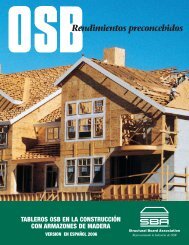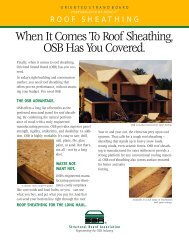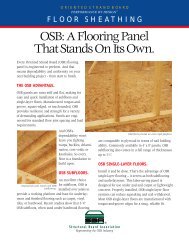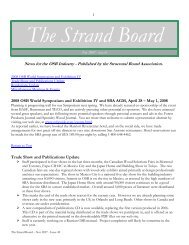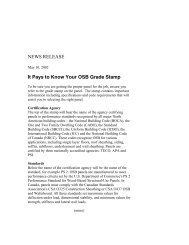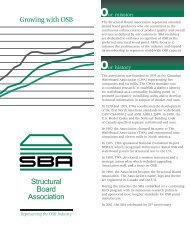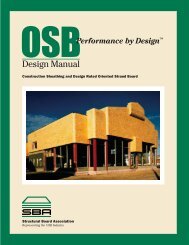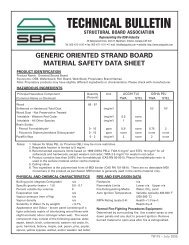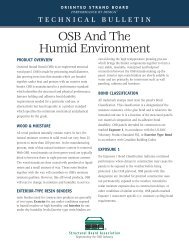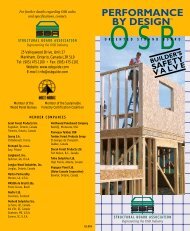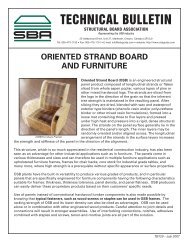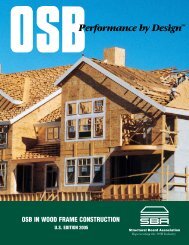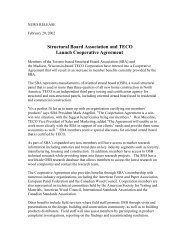Lots of Upside for Value-Added OSB and New Markets - OSBGuide
Lots of Upside for Value-Added OSB and New Markets - OSBGuide
Lots of Upside for Value-Added OSB and New Markets - OSBGuide
Create successful ePaper yourself
Turn your PDF publications into a flip-book with our unique Google optimized e-Paper software.
NEWS RELEASE<br />
July 28, 2000<br />
<strong>Lots</strong> <strong>of</strong> <strong>Upside</strong> <strong>for</strong> <strong>Value</strong>-<strong>Added</strong><br />
<strong>OSB</strong> <strong>and</strong> <strong>New</strong> <strong>Markets</strong><br />
What structural panel is used the most in North American residential<br />
construction? If you answered oriented str<strong>and</strong> board (<strong>OSB</strong>), you’re right on<br />
the money.<br />
<strong>OSB</strong>’s share <strong>of</strong> the floor <strong>and</strong> wall sheathing <strong>and</strong> ro<strong>of</strong> decking market has<br />
tripled to around 75 percent in the last 10 years. Although the residential<br />
market is expected to reach saturation point soon, manufacturers will focus<br />
on upgrading panel quality <strong>and</strong> per<strong>for</strong>mance <strong>of</strong> <strong>OSB</strong>, which will continue<br />
to play a pivotal role in home construction, due to product advantages <strong>and</strong><br />
the market.<br />
Engineered wood products, like <strong>OSB</strong>, are beginning to replace traditional<br />
lumber in home construction. Processed with wood <strong>and</strong> adhesives, they<br />
exhibit stronger properties than their sawn lumber counterparts, <strong>and</strong> have<br />
not only caught on among architects <strong>and</strong> builders but are appreciated by<br />
home buyers.<br />
Larger homes will also require more product, including <strong>OSB</strong>. From 1,000<br />
square feet in 1950 to 2,000 square feet today, the National Association <strong>of</strong><br />
Home Builders estimates new homes will average 2,200 square feet by<br />
2010. Larger garages, larger rooms <strong>and</strong> higher ceilings will require more<br />
paneling, sheathing <strong>and</strong> flooring supporting longer spans.<br />
<strong>Upside</strong> <strong>OSB</strong> – page 2<br />
(1)
The market will remain lucrative <strong>for</strong> those who deliver on product.<br />
Although interest rates are expected to take a bite out <strong>of</strong> the furious pace <strong>of</strong><br />
housing starts in the United States, don’t <strong>for</strong>get that more than 50 percent<br />
<strong>of</strong> the U.S. population by 2010 will be between 25-64 years old. That<br />
demographic will spend the most on buying new homes, building new ones<br />
or renovating existing homes. Boomers will make up half <strong>of</strong> this group.<br />
Many <strong>of</strong> these folks will be from double-income families. As the case is<br />
now, they will dem<strong>and</strong> <strong>and</strong> pay <strong>for</strong> more quality in home components <strong>and</strong><br />
products. Manufacturers realize this as much as builders. If the old<br />
sheathing panels that builders referred to as “commodity” were classified<br />
as regular gasoline, the panels that you will see today <strong>and</strong> in the future will<br />
be closer to premium with one great exception: They will be priced more<br />
competitively.<br />
No longer will every pr<strong>of</strong>essional identify <strong>OSB</strong> as a sheathing panel, <strong>for</strong><br />
companies are producing new specialty panels as well as engineered<br />
components that are beginning to take over important parts <strong>of</strong> the<br />
residential construction process that were not associated with <strong>OSB</strong>.<br />
I-joists, which began to appear on the market in the 1990s, are expected to<br />
support more than half <strong>of</strong> new homes that will be built in the United States<br />
in several years. Made <strong>of</strong> <strong>OSB</strong> webs connected by lumber or laminated<br />
veneer lumber flanges, I-joists do not tend to crown, shrink, split, warp,<br />
twist or pull away from the subfloor like sawn lumber joists. They are<br />
lighter, strong enough to carry large loads <strong>and</strong> reduce or eliminate squeaky<br />
floors. I-joists are among the fastest-selling wood products in residential<br />
construction. <strong>OSB</strong> tends to be the most pr<strong>of</strong>itable.<br />
Structural insulated panels (SIPs), made up <strong>of</strong> a core foam s<strong>and</strong>wiched by<br />
<strong>OSB</strong> panels, have achieved a 5 percent market share in residential<br />
construction, but a critical mass <strong>of</strong> acceptance is beginning to be felt among<br />
builders <strong>and</strong> architects catering to households seeking high insulation,<br />
com<strong>for</strong>t, strength <strong>and</strong> sound-pro<strong>of</strong>ing characteristics.<br />
SIPs <strong>of</strong>fer cost advantages <strong>for</strong> builders. A small custom house with SIPs<br />
can be built, sheathed, insulated <strong>and</strong> sealed <strong>for</strong> air tightness in one day.<br />
When a company like Owens Corning, a home products giant, starts a new<br />
line <strong>of</strong> SIPs like it did last year, you know the product, as well as <strong>OSB</strong>, will<br />
benefit from the firm’s huge distribution system.<br />
<strong>Upside</strong> <strong>OSB</strong> – page 3<br />
(2)
Manufacturers are also doing some wonderful things with panels. One firm<br />
has successfully introduced an <strong>OSB</strong> panel incorporating per<strong>for</strong>ated<br />
aluminum, which acts as a barrier to keep out as much as 95 percent <strong>of</strong> the<br />
sun’s radiant heat. Firms are also <strong>of</strong>fering lifetime or 50-year warranties <strong>for</strong><br />
flooring systems combing <strong>OSB</strong> tongue <strong>and</strong> groove panels with I-joists.<br />
Another firm is <strong>of</strong>fering an <strong>OSB</strong> concrete <strong>for</strong>m product that will be used<br />
<strong>for</strong> industrial applications to build concrete walls <strong>and</strong> foundations. Up until<br />
now plywood has dominated in this particular application. The product<br />
consists <strong>of</strong> an <strong>OSB</strong> panel with a medium density overlay, which allows <strong>for</strong><br />
multiple usage. This is the first time that <strong>OSB</strong> will be used as a concrete<br />
<strong>for</strong>m. It also spells the beginning <strong>of</strong> a <strong>for</strong>ay into the industrial market <strong>and</strong><br />
<strong>OSB</strong> diversifying into new markets.<br />
###<br />
For additional in<strong>for</strong>mation about <strong>OSB</strong>, contact the Structural Board<br />
Association at (416) 730-9090, fax (416) 730-9013 or e-mail<br />
info@osbguide.com. The SBA Web site (www.osbguide.com) is another<br />
excellent resource.<br />
.



